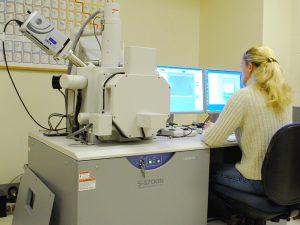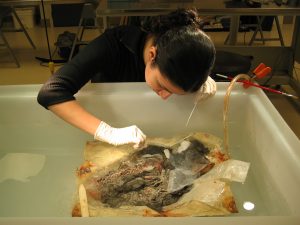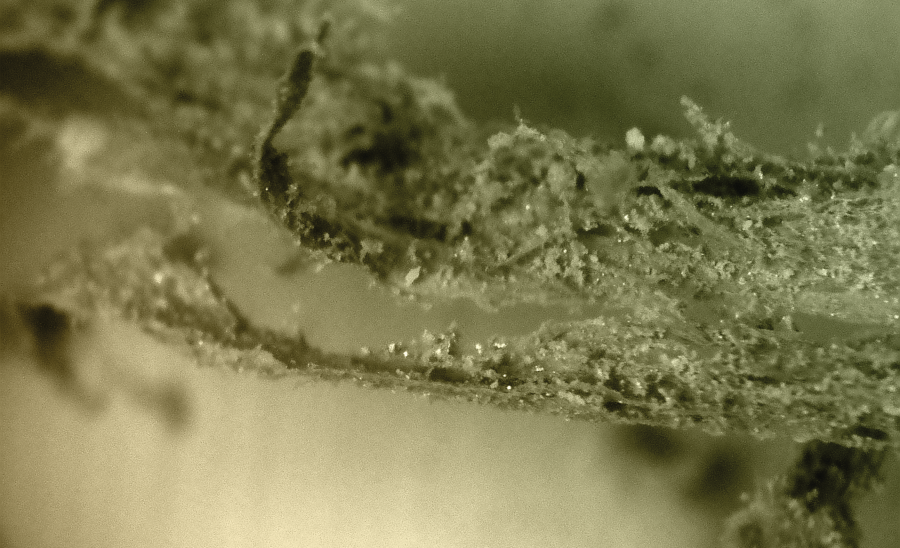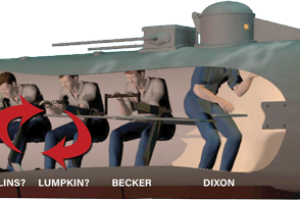
Stéphanie Cretté, Director of the Warren Lasch Conservation Center at the Clemson University Restoration Institute, working on the state-of-the-art Variable Pressure Scanning Electron Microscope.
The Hunley represents a unique challenge in the field of conservation. Recovered from the ocean floor in 2000, the legendary submarine was in essence a time capsule, holding a wide array of artifacts from the 19th century. Taken together, these artifacts tell a fascinating story about life during the Civil War. They also present a complicated scenario for scientists working to save them for future generations.
EVERY ARTIFACT IS UNIQUE
Each artifact requires a specific conservation treatment based on their composition and current condition. And there is no shortage of materials on the submarine. From iron, wood, copper, silver, gold, and cloth – just to name a few – conserving the hundreds of artifacts found on the Hunley is a daunting task. Further complicating matters, the materials are often so deteriorated, it is hard to even identify their composition.
In these instances, Clemson University’s state-of-the-art Variable Pressure Scanning Electron Microscope (VP-SEM) is an invaluable tool for the close examination of surfaces. The microscope uses a concentrated beam of high-energy electrons to evaluate the makeup of an item at the atomic level. It requires placing a sample in a completely sealed off—and very small—vacuum chamber for analysis. The resulting image is called a micrograph. It can help identify a material or help take a closer look at the damage or corrosion that has been suffered by an artifact. These factors are essential in developing an effective preservation plan.

A micrograph of Dixon’s cashmere vest, which aided the team in mapping out a plan for conservation. INSET: Thread type micrographs.
DIXON’S CLOTHING UNDER THE MICROSCOPE

Johanna Rivera works on Dixon’s vest before conservation.
The microscope proved instrumental in identifying and treating the clothing of Hunley Captain Lt. George Dixon. Found intermingled with his remains, the material was impossible to identify. Using the microscope, which has a magnification capability anywhere from 10x to 500,000x, the team was able to zoom in for a much closer look. At this level, every material has a core signature. Cotton has very distinct twists while wool is made up of thousands of fish-like scales. Silk, on the other hand, has smooth, graceful strands.
Thanks to the perspective offered by the electron microscope, conservators were able to determine Dixon’s shirt was made of cotton and his jacket and vest were made of cashmere, while his pants were regular sheep’s wool. From there, they mapped out a plan for their preservation.
Everyone knows science and archaeology can be tools to learn and preserve history. It can also give us glimpses into the personalities of important historical figures. For example, scientific work has helped us understand more about George Dixon, the man who led the Hunley and her crew into world history. Found among the remnants of his cotton and wool clothing were silver suspender clasps. During the conservation process, scientists uncovered what appear to be his initials engraved on the suspender buckle. Silver suspender clasps, imprinted with personal marks make this suspender clasp a high-end accessory for the time. This alone starts to paint a portrait of a man of at least some financial means with an eye toward how he presented himself.




